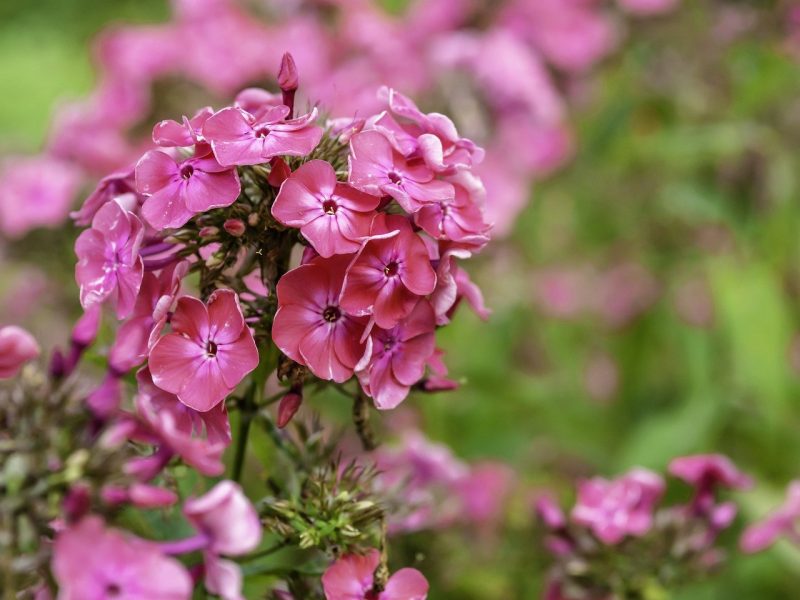Knowing how to prune phlox is as simple as knowing the practices for summer and winter. Besides deadheading, pruning is another maintenance technique that you must do to phlox to encourage blooming and extend it. More so, you might notice a difference in growing phlox in the greenhouse because they don’t experience fluctuating conditions.
Remember that phlox grows best in growing zones 4 to 8, which gives you an idea of where they would thrive best. Phlox is also a large group of perennials, so choose the ones that will thrive best in your region. Otherwise, the plant is relatively easy to grow and maintain.

How To Prune Phlox Successfully
Pruning phlox doesn’t have to be complicated as long as you get the timing right. In general, you can prune phlox in summer and winter as part of maintenance. However, note that there are different types of phlox, so you may need to do additional practices.
Overall, pruning phlox will not only keep the plants from overgrowing and looking untidy. Preventing overcrowding will also avoid diseases like powdery mildew out of poor air circulation. More so, you can prevent the spread of fungi if you always cut back the stems after flowering.
Summer pruning
Phlox blooms in the summer, and you can cut back the flowering stems throughout this period. You can also do this once a month to lengthen the blooming period and encourage bloom production. A useful signal for cutting dead flowers and trimming stems is when more than half of your plant’s flowers have died.
As for maintenance, you can also prune in summer when your phlox has overgrown its space. Remember that some phlox species’ creeping habit will require you to prune them to keep them within their area and at the desired height. You can do this from spring to summer as they grow.
Winter pruning
Besides summer, winter is also another excellent time to prune phlox. Specifically, you can maintain creeping phlox in late winter to keep them from overgrowing the mat. You can cut back their edges to maintain the width.
More so, you want to remove the old non-flowering stems of your phlox in late winter. You’ll see these woody stems at the plant’s center, and you can cut them at the base. Don’t worry about losing this old part of the phlox because this technique will rejuvenate the plant in summer with new flowering stems.
Pruning is also a part of winter care. You want to cut back the plant until it’s above the soil after the first killing frost. You can also use this as an opportunity to remove the parts with powdery mildew.
Caring And Maintaining Phlox
Perhaps you are already aware that phlox requires regular watering, especially during the summer. Keeping the soil moist is essential for their health, so you can mulch the area to conserve water. However, do not keep the plants in standing water that can encourage diseases.
How do you fertilize phlox? You will fertilize at planting time, and you can also feed the plants lightly before the blooming season. Some gardeners even repeat feeding after the flowers fade to encourage repeat blooming.
You can use a greenhouse to maintain phlox as well and use a slightly alkaline well-draining soil. You can encourage healthy blooms by placing your plants somewhere that receives full sun or light exposure for around 6 hours daily. The environment itself doesn’t have to be cold as some phlox species tolerate dryness and humidity.
What Is The Difference Between Tall Phlox And Creeping Phlox?
When researching pruning and caring for phlox, you can get confused if you don’t know the differences between tall phlox and creeping phlox. You can easily understand the two by remembering that the tall phlox is also the garden phlox, which means they are not ground-hugging like the creeping phlox. On the other hand, creeping phlox has needle-like leaves and are meant to be ground covers and stays green throughout winter.
Overall, tall phlox can work as a part of the perennials you show in the garden because of their height. Creeping phlox is meant to add texture or color close to the ground because their size isn’t obstructive. But regardless of which phlox you grow, pruning and caring for phlox are mandatory for healthy blooms and a neat look.
Conclusion
Phlox species are one of the best plants to grow if you don’t want numerous maintenance practices. However, it would be best if you still learned how to prune phlox correctly to keep them from overgrowing and getting overcrowded. More so, regular pruning would rejuvenate the plant and even encourage blooming or extend the season itself.
You can prune phlox in summer and winter. Summer pruning will extend and encourage the flowering of your plants. In contrast, winter pruning can be an opportunity to remove the dead parts of the plant or those potentially infected by powdery mildew. Lastly, you can maintain the soil moisture and fertilizing in an ideal environment to keep your phlox plants happy and blooming without issues.
The greenhouse makes an excellent option for growing phlox, especially if your region experience fluctuating climates. It would also be best to identify the type of phlox you have to adjust the conditions for them and required maintenance practices. Start by learning the difference between tall phlox and creeping phlox, and do your research accordingly.
